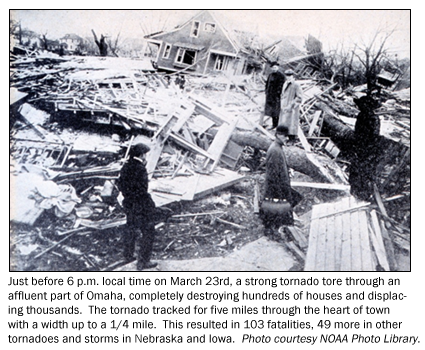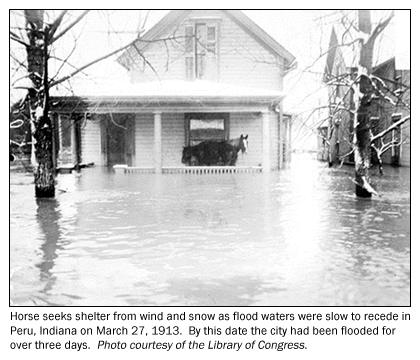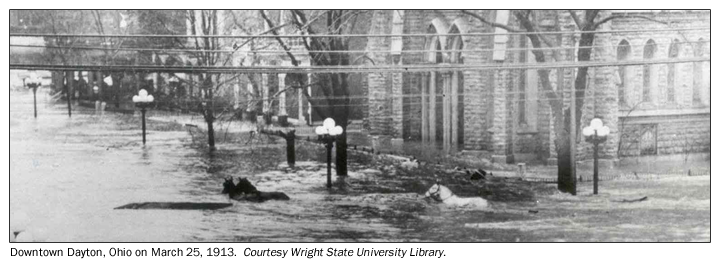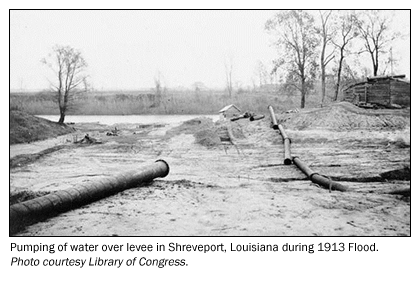The Great Flood of 1913
100 Years Later
Overview of the March 1913 Flood
"A national calamity"
The floods of March 1913 wrought such great devastation as never before witnessed in America. An area of over a thousand miles long and several hundred miles wide saw devastating flooding after heavy rain fell over the Ohio Valley and northeast between March 23rd and 27th. Most rivers from Indiana to Connecticut were in flood, many of which reached stages never seen before or since. Every river community in Ohio and Indiana was inundated to some degree, and several considered devastated. When the flood water finally receded, the estimated damages exceeded $300 million and at least 600 people had lost their lives (though sources differ on the exact number). The storm system that brought the torrential rain also brought tornadoes over the northern plains and over the south resulting in several hundred more fatalities. When the weather finally cleared, over a quarter million Americans were left homeless and over a thousand people had perished.  It was a rare combination of meteorological conditions that brought about these series of disasters.
It was a rare combination of meteorological conditions that brought about these series of disasters.
"The 'devil cloud' had made its horrifying appearance..."
Prior to the flooding, violent storms had brought strong winds, blizzards, and tornadoes to parts of the Midwest from March 13-15th. A most unique event occurred on March 21st as hurricane force winds were observed for an extended duration at Detroit, Toledo, and Buffalo, with strong gales across the entire lakes region. This wind storm resulted in widespread damage killing approximately half a dozen people mainly from collapsing chimneys and buildings. A series of tornadoes associated with this system tore through Missouri, Arkansas, Tennessee, Alabama, and Louisiana killing at least fifty people.
By Easter weekend, most residents in the Ohio Valley considered themselves lucky if they still had a roof over their heads and a working phone and electrical connections. Few realized that the next storm system was soon approaching. By Sunday March 23rd another area of low pressure moved out of the Rockies. This storm system brought the worst dust storm to Kansas prior to the dustbowl years, severe thunderstorms to Missouri, and tornadic storms to the northern plains including the hardest hit Omaha, Nebraska and Terre Haute, Indiana where 152 persons perished. As it moved into  the Ohio Valley the storm system had transitioned more into a heavy rain maker. Before the rain from this storm system had completely pushed east, another storm system moved from Texas into the Ohio Valley. A front associated with this system stalled over southern Indiana and central Ohio for over 48 hours. Moisture from the Gulf of Mexico supported torrential rainfall during this period. The rain finally came to an end on the 27th when a cold front pushed its way east. When all was said and done, 1 to 6 inches of rain had fallen from Illinois to Maine and as far south as Missouri, with a bullseye of 6 to 11 inches of rain over Indiana, Ohio, northwest Pennsylvania, and western Kentucky.
the Ohio Valley the storm system had transitioned more into a heavy rain maker. Before the rain from this storm system had completely pushed east, another storm system moved from Texas into the Ohio Valley. A front associated with this system stalled over southern Indiana and central Ohio for over 48 hours. Moisture from the Gulf of Mexico supported torrential rainfall during this period. The rain finally came to an end on the 27th when a cold front pushed its way east. When all was said and done, 1 to 6 inches of rain had fallen from Illinois to Maine and as far south as Missouri, with a bullseye of 6 to 11 inches of rain over Indiana, Ohio, northwest Pennsylvania, and western Kentucky.
"A great mountain of water has been hurled from the clouds..."
Unusually high water was reported as early as Monday the 24th over northeast Indiana and northwest Ohio including the towns of Fort Wayne, Elwood, Marion, Kokomo, Winchester, Huntington, and Wabash in Indiana and Fremont, Findlay, West Liberty, Ottawa, and Toledo in Ohio. By late Monday night, all of these river communities saw record floods. By early Tuesday morning, the levees broke in Indianapolis, Indiana, Dayton, Ohio and Columbus, Ohio resulting in flood waters of depths reaching 15 to 18 feet. By that afternoon, all river communities in Ohio were flooded. By Tuesday night the headwater rivers in Ohio and Indiana began to recede, but given the extreme stages reached many stayed flooded well into Thursday. In Terre Haute, Indiana, a town recently ravaged by a tornado that resulted in 21 deaths, the river soon rose to an unprecedented stage.
The heavy rains that gradually moved into New York and Pennsylvania, and then New England, were not as significant as that seen in Indiana and Ohio, though the damage was still considerable. By far the worst damage in Pennsylvania was on the Shenango and Beaver Rivers in the northwest part of the state. In New York, many cities, including Albany, Rochester, and Buffalo were flooded.

"A mighty deluge, an avalanche of waters, had suddenly stricken..."
As the flood waters moved down the tributaries, they reached the Ohio River. In Cincinnati the volume of waters coming out of the Great Miami River was so significant that it backed up the Ohio River. Between Pittsburgh and Cairo several towns observed record flood stages. Levees still in disrepair from the 1912 floods could not take the pressure of the flood waters coming out of the Ohio Valley and several broke on the Ohio and Mississippi Rivers. The flood waters that fell in March did not flush out into the Gulf of Mexico until late May. Though few lives were lost on these two rivers, the amount of property damage and destruction was enormous. 
The weather pattern that formed the series of storms in March of 1913 was rare and extreme, but we cannot rule out the possibility that it could happen again. If the Ohio Valley were to receive a rainfall event similar to the March 1913 event, would conditions be better or worse? No matter how high the rivers rise in future floods, citizens today have advantages not available in 1913. Dozens of local, state, and federal agencies, along with the private sector and academia, have worked hard over the last century to reduce flood risk. If the flood waters come again, the people of the Ohio Valley have resources and tools available to help communities prepare, respond, and recover.
Quotations from "America's greatest flood and tornado calamity: authentic story of these appalling disasters..." by Herbert v. Prochnow via Google eBooks.
